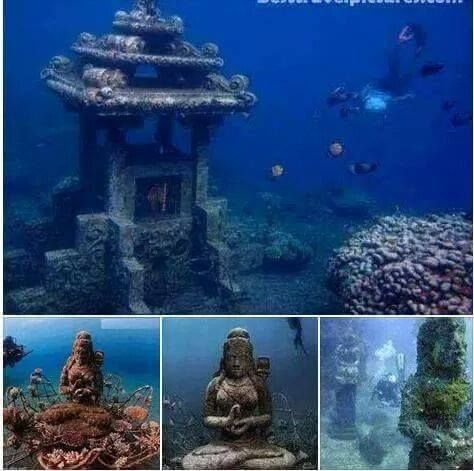KUMARI KANDAM
Kumari Kandam refers to a mythical lost continent with an ancient Tamil civilization, located south of present-day India, in the Indian Ocean.. Alternative name and spellings include Kumarikkantam and Kumari Nadu. In the 19th century, a section of the European and American scholars speculated the existence of a submerged continent called Lemuria, to explain geological and other similarities between Africa, Australia, India and Madagascar. A section of Tamil revivalists adapted this theory, connecting it to the Pandya legends of lands lost to the ocean, as described in ancient Tamil and Sanskrit literature. According to these writers, an ancient Tamil civilization existed on Lemuria, before it was lost to the sea in a catastrophe. In the 20th century, the Tamil writers started using the name "Kumari Kandam" to describe this submerged continent. Although the Lemuria theory was later rendered obsolete by the continental drift (plate tectonics) theory, the concept remained popular among the Tamil revivalists of the 20th century. According to them, Kumari Kandam was the place where the first two Tamil literary academies (sangams) were organized during the Pandya region. They claimed Kumari Kandam as the cradle of civilization to prove the antiquity of [Tamil language] and culture.
MYSTERY OF KUMARI KANDAM:
Pandiyan Kings ruled almost for 10,000 years on the continent of Lemuria before it got submerged under water. The Lemuria continent better referred as ‘Kumari Kandam’ was located between the Indian and Pacific Oceans, connecting Africa with South India through Madagascar. Though vital scripts on this legendary lost continent is not available today but still some reference in the Tamil and Sanskrit literature can confirm the existence of this marvelous land peace that existence once centuries ago. Recent ocean exploration work in the Indian Ocean, south of present day Kanyakumari district of South India has further strengthened the belief .It is an irony and perhaps the most saddened stories of the time that with submersion of the Kumari Kandam continent, once the highly prosperous commercial city, the capital of Chola Kingdom, Poompuhar and six of the colossal temples of Mahapalipuram out of the seven has been and remain today totally submerged under water.One of the eminent professor of the University of Jaffna, Dr. A.Shanmugathas, head of the department of Tamil, confirms the lost of Kumari kandam in his findings. It is said that a big Tsunami like catastrophe occurred during those times which broke and submerged the continent. The Sangam Literature, which is said to be more than 2,000 yrs old refer to similar natural catastrophes which occur time to time in those areas and which affected and destroyed the Tamil speaking world of those times. Other deliberations and talks on the Lemuria continent can be found out from the literary works of people of eminence around the world. Professor Karsten M. Storetvedt, the chair in geomagnetism at the University of Bergen, Norway, and an author of the Global Wrench Theory (GWT), says that the equator regions have always been most prone to natural catastrophes like earthquakes and volcano eruptions. A part of explanation is that planet rotation and especially the difference in rotation speed between poles and equator force earth mantel to strain and to break more easily where the strain is strongest, that is at the equator regions. These tectonic processes played important role in the disappearance of the ancient continent known as Lemuria (Kumari Kandam) to western scholars. Sri Lanka together with India, Indonesia and Malaysia were a part of this continent. Many islands in the Pacific and Indian oceans are remnants of this continent that in ancient time covered the whole area of today’s ocean. Storetvedt, who seems to reject the theory of continental drift and plate tectonics, says that descriptions of cataclysms in early literature when land suddenly went underwater are logical. But they should be proven to be scientific facts. This can be done with the help of sea-floor analysis that is possible to carry out. Modern theories find supportive evidences both in ancient literature and language history.
So, how much truth is there in the story of Kumari Kandam? According to researchers at India’s National Institute of Oceanography, the sea level was lower by 100 m about 14,500 years ago and by 60 m about 10,000 years ago. Hence, it is entirely possible that there was once a land bridge connecting the island of Sri Lanka to mainland India. As the rate of global warming increased between 12,000 and 10,000 years ago, the rising sea levels resulted in periodic flooding. This would have submerged prehistoric settlements that were located around the low-lying coastal areas of India and Sri Lanka. Stories of these catastrophic events may have been transmitted orally from one generation to another and finally written down as the story of Kumari Kandam. We can find mention of “Kumari Knadam” from various other sources also. According to Silappadhikaram, one of the five great epics of Tamil Literature written in second centuries CE, states that the cruel sea took the Pendiyan’s land, part of which was present between the rivers Pahruli and the mountainous banks of the Kumari. These rivers are said to have flowed in a now-submerged land. Adiyarkkunallar, a 12th century CE commentator on the epic, explains this reference by saying that there as once a land to the south of the present day Kanyakumari, which stretched for 700 kavatam from the Pahruli river in the north to the Kumari river in the south. The modern equivalent of the measurement kavatam, which is also known as katam in Tamil, is a distance of 6.25 miles (10.06 km.). 700 kavatam equals to 4,375 miles (7,041 km.). It is a saddened fact that the lost continent of Lemuria or Kumari Kandam sunk into the Indian Ocean 1000s of years ago, and with vanished the most prosperous and a humongous Tamil civilization. In the following video you may get a glimpse of Kumari Kandam.
GOUTHAMI.S
TRAVEL TINKERS.


It's really amazing
ReplyDeleteawesome
ReplyDeletedamn just cool
ReplyDelete